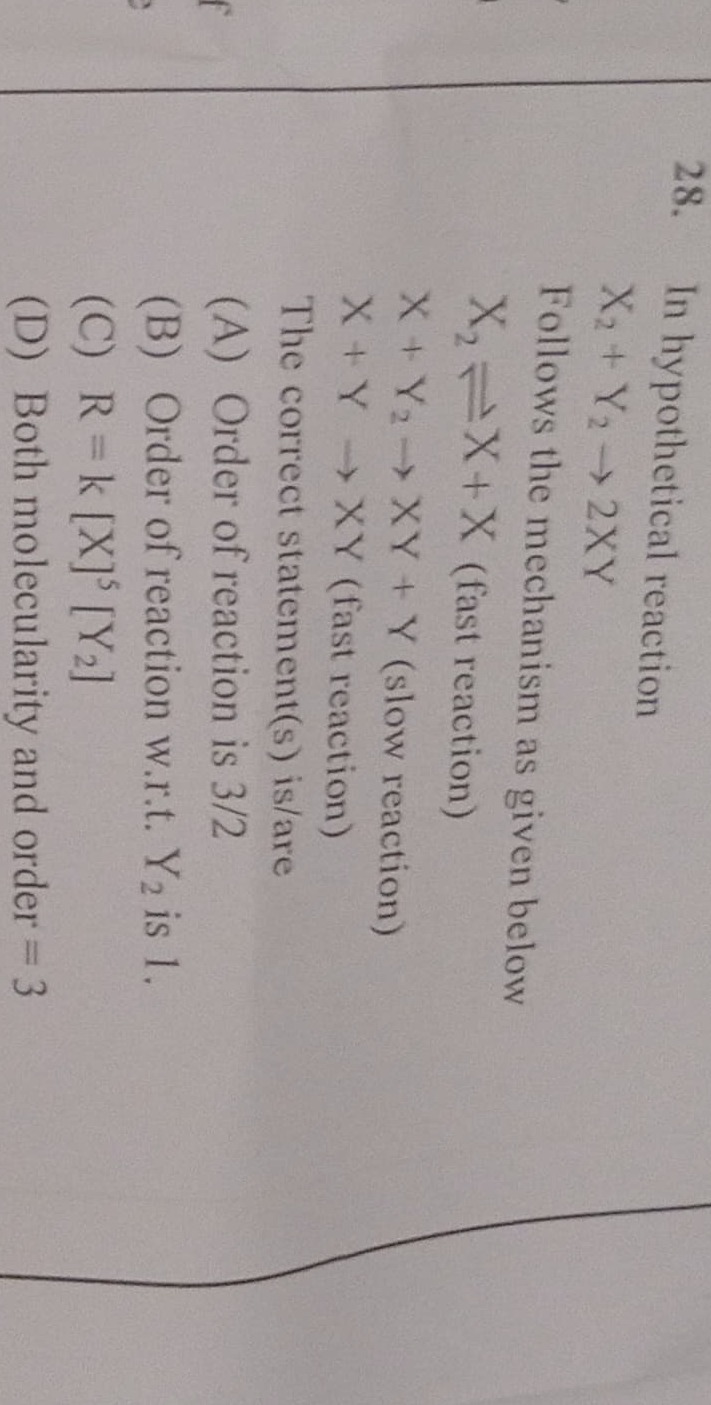Question
Question: In hypothetical reaction $X_2 + Y_2 \rightarrow 2XY$ Follows the mechanism as given below $X_2 \rig...
In hypothetical reaction X2+Y2→2XY
Follows the mechanism as given below X2⇌X+X (fast reaction) X+Y2→XY+Y (slow reaction) X+Y→XY (fast reaction) The correct statement(s) is/are

Order of reaction is 3/2
Order of reaction w.r.t. Y2 is 1.
R = k [X]5[Y2]
Both molecularity and order = 3
A, B
Solution
The reaction mechanism is given as:
- X2⇌X+X (fast reaction)
- X+Y2→XY+Y (slow reaction)
- X+Y→XY (fast reaction)
Step 1: Determine the rate law from the slow step.
The rate of a reaction is determined by its slowest step (rate-determining step). From the slow reaction (Step 2): Rate (R) = kslow[X][Y2]
Step 2: Express the concentration of the intermediate in terms of reactants.
In the rate law, [X] is an intermediate species. Its concentration needs to be expressed in terms of the reactant X2. We use the fast equilibrium step (Step 1) for this. For the equilibrium X2⇌X+X: The equilibrium constant Keq is given by: Keq=[X2][X][X]=[X2][X]2
Solving for [X]: [X]2=Keq[X2] [X]=(Keq[X2])1/2=Keq1/2[X2]1/2
Step 3: Substitute the intermediate concentration into the rate law.
Substitute the expression for [X] into the rate law from Step 1: R = kslow(Keq1/2[X2]1/2)[Y2]1 R = (kslowKeq1/2)[X2]1/2[Y2]1
Let the new overall rate constant k=kslowKeq1/2. So, the final rate law is: R = k[X2]1/2[Y2]1
Step 4: Determine the order of the reaction and evaluate the statements.
- Order with respect to X2: From the rate law, the exponent of [X2] is 1/2.
- Order with respect to Y2: From the rate law, the exponent of [Y2] is 1.
- Overall order of reaction: Sum of the individual orders = 1/2+1=3/2.
Now let's evaluate each statement:
(A) Order of reaction is 3/2 This statement is correct, as the overall order calculated is 3/2.
(B) Order of reaction w.r.t. Y2 is 1. This statement is correct, as the order with respect to Y2 is 1.
(C) R = k [X]5[Y2] This statement is incorrect. The rate law should be in terms of reactants (X2 and Y2), not an intermediate (X), and the exponents are incorrect.
(D) Both molecularity and order = 3 Molecularity is defined for elementary steps, not for the overall complex reaction. For the slow step (X+Y2→XY+Y), the molecularity is 2. The overall order is 3/2, not 3. Therefore, this statement is incorrect.
Based on the analysis, statements (A) and (B) are correct.
